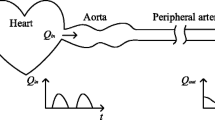Abstract
Volume elasticity of the arterial system and its component parts is developed starting from a Windkessel*-model, which is defined in 4 points. Emphasis is laid on the simplicity of the derived equations and accessibility to experimental verification. The theory is an extension of earlier work achieved by Wetterer and Pieper (1953), who introduced an essentially physical method for the indirect determination of volume elasticity in situ, by creating forced sinusoidal oscillations in the arterial system, using a special pump operated at a considerably lower frequency than the mean heart frequency. The elegance of both experimental technique and the derived equations incited us to investigate the mathematical foundation and possible generalization of the method.
Similar content being viewed by others
Literature
Broemser, Ph. and O. F. Ranke. 1930. “Ueber die Messung des Schlagvolumens der Herzens auf unblutigen Wege.”Z. Biol.,90, 467–507.
Cope, F. W. 1961. “A Method for the Computation of Aortic Distensibility in the Living Human Patient and its Use for the Determination of the Aortic Effects of Aging, Drugs, and Exercise.”Bull. Math. Biophysics,23, 337–353.
—. 1962. “A modified Windkessel Theory of the Human Arterial System using Modern Data on Aortic Elasticity, so as to Yield Computational Accuracy, Sufficient for Clinical Usefulness.” Symposium on the Development of Analog Computers in the Study of the Mammalian Circulatory System. North Holland Publ. Cie. Utrecht (Netherlands).
Fabre, Ph. 1932. “Utilization des Forces Electromotrices d'Induction pour l'Enregistrement des Variations de Vitesse des Liquides Conducteurs: un Nouvel Hémodromographe sans Palette.”Compt. Rend.,194, 1097–1098.
Frank, O. 1899. “Die Grundform des Arteriellen Pulses.”Z. Biol.,37, 483–526.
—. 1927. “Die Theorie der Pulswellen.”Z. Biol.,85, 91–130.
Hallock, P. and I. C. Benson. 1937. “Studies on the Elastic Properties of Human Isloated Aortas.”J. Clin. Invest.,16, 595–602.
Hamilton, W. F., J. W. Moore, J. M. Kinsman, and R. G. Spurling. 1928. “Simultaneous Determination of the Pulmonary and Systemic Circulation Times in Man and a Figure Related to the Cardiac Output.”Am. J. Physiol.,84, 338–344.
Jaeger, M. 1962. “Etude de l'Elasticité et des Tensions de la Carotide de Vache en Comparaison avec l'Aorta et la Coronaire.”Helv. Physiol. Acta,20, 7–24.
Kenner, Th. and E. Wetterer. 1962. “Experimentelle Untersuchungen über die Pulsformen und Eigenschwingungen zweiteiliger Schlauchmodelle.”Arch. Ges. Physiol.,275, 594–613.
King, A. L. 1946. “Pressure-Volume Relation for Cylindrical Tubes with Elastomeric Walls.”J. Appl. Phys.,17, 501–505.
Kulbertus, H. 1963. “Effect of Different Vasomotor Agents on the Visco-elastic Behavior of Arteries of the Muscular Type.”Nature,199, 1193–1194.
Morgan, G. W. and J. P. Kiely. 1954. “Wave Propagation in a Viscous Liquid Contained in a Flexible Tube.”J. Acoust. Soc. Am.,26, 323–328.
Pieper, H. P. 1958. “Measurement of Aortic Blood-Flow, with a New Catheter-Tip Flow Meter.”Rev. Sci-Instr.,29, 965–971.
Rainville, E. D. 1958.Differential Equations. New York: the Macmillan Publishing Co.
Rashevsky, N. 1963. “The Principle of Adequate Design and the Cardiovascular System.”Bull. Math. Biophysics,25, 59–73.
Remington, J. W. and W. F. Hamilton. 1945. “The Construction of a Theoretical Cardiac Ejection Curve from the Contour of the Aortic Pressure Pulse.”Am. J. Physiol.,144, 546–556.
—, C. B. Noback, W. F. Hamilton, and J. J. Gold. 1948. “Volume Elasticity Characteristics of the Human Aorta and the Prediction of the Stroke Volume from the Pressure Pulse.”Am. J. Physiol.,153, 298–302.
Treloar, L. R. G. 1958. “The Physics of Rubber Elasticity.” Oxford: Clarendon Press.
Wetterer, E. and H. Pieper, 1953. “Ueber die Gesamtelastizität des arteriellen Windkessels und ein experimentelles Verfahren zu ihrer Bestimmung am lebenden Tier.”Z. Biol.,105, 23–57.
Wezler, K. 1938. “Der Ruhezustand des Kreislaufes.”Z. Biol.,98, 438–463.
Womersley, J. R. 1955. “Oscillatory Motion of a Viscous Liquid in a Thin Walled Elastic Tube.”Phil. Mag.,46, 199–221.
—. 1957. “Oscillatory Flow in Arteries: the Constrained Elastic Tube as a Model of Arterial Flow and Pulse Transmission.”Phys. Med. Biol.,2, 178–187.
Author information
Authors and Affiliations
Rights and permissions
About this article
Cite this article
Lewi, P.J. Forced oscillations in a windkessel model. Bulletin of Mathematical Biophysics 27, 271–280 (1965). https://doi.org/10.1007/BF02478404
Received:
Issue Date:
DOI: https://doi.org/10.1007/BF02478404



